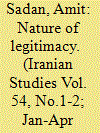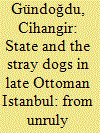| Srl | Item |
| 1 |
ID:
177796


|
|
|
|
|
| Summary/Abstract |
This article examines history-writing in Safavid Iran and, in particular, the notable chronicle from the time of Shah ʿAbbas I, the Tārīkh-e ʿĀlam-ārā-ye ʿAbbāsī (TAAA). It rethinks Safavid history-writing via the perspective of environmental history. This article asks, “How was the natural world represented in the chronicle, and in what way did this representation shape the Safavid historical narrative?” It argues that the ways in which the TAAA portrays human encounters with nature suggest ʿAbbas’ unique sovereignty over it. Because of his piety and devotion, he was considered blessed with divine grace, making him the only human being with the ability to regulate natural manifestations—that is, to dominate, to manipulate, to survive, and to contain nature. Against a backdrop of an absence of environmental readings of Safavid history, the article suggests looking at the TAAA’s representation of this natural world as a powerful legitimizing force for ʿAbbas’ reign, as it is one that has not yet been foregrounded.
|
|
|
|
|
|
|
|
|
|
|
|
|
|
|
|
| 2 |
ID:
159008


|
|
|
|
|
| Summary/Abstract |
The present article situates the systemic efforts to annihilate stray dogs within the wider picture of Ottoman modernizing reforms in the nineteenth century. The period under investigation witnessed an increasing desire on the part of the modern Ottoman state to control and reform disenfranchised human and animal groups, which were believed to jeopardize public order, security and hygiene. These groups – beggars, orphans and the unemployed – were identified as actors irreconcilable with the modern image that the reforming bureaucracy and modernizing elites sought to project. In the face of increasing challenges from European powers, they were the epitome of underdevelopment and backwardness. Ottoman elites and official authorities therefore proposed and implemented institutional measures in the form of forced labor, reformatories or deportation to reform the conditions of these groups, segregate them from the greater public and discipline them. In the modern period, along with the proposals that called for the removal of dogs, modernizing intellectuals and professionals proposed alternative plans to render non-human animals beneficial to human needs and the modern state's expectations.
|
|
|
|
|
|
|
|
|
|
|
|
|
|
|
|